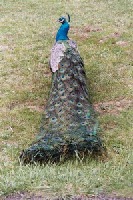Rocky's Tale |
|
We got Rocky from Marci Clark, who had put an ad in the
Gamebird Gazette.
Marci didn't know his age, but Rocky was probably pretty old already.
My husband brought him and three others home in burlap bags arranged in a neat
line in the car trunk, with the seat pass-thru and all the windows open, to
provide plenty of fresh air. Joe also played soothing music and talked to the
birds whenever they got restless during the 5-hour drive. This was July, 2005.
I noticed that there was something wrong with one of Rocky's feet as soon as we unloaded him from the trunk. He didn't walk very well, never fully straightened his knees, and was unwilling or unable to fly into the trees that evening. We decided to always keep him in the garage at night, for his own safety. Within the first week, we bundled Rocky off to the vet and had his foot X-rayed. His big middle toe had been broken at some point and had never healed properly. It was swollen, infected, flopped around loosely, and was obviously painful. We had the vet amputate it. Back at home, we had to give Rocky antibiotic pills (hidden inside a grape) twice a day for 10 days, and also had to change his bandage every 2 or 3 days, which meant he had to get caught and handled a lot. What impressed us right away about Rocky was that he was so nice, and easy to handle. He didn't try to peck or scratch or hit us with his wings, like a bad-tempered bird would have done. Nor was he excessively timid. And we gradually realized that despite his tiny head and brain, Rocky was smart. |

|
|
It soon became apparent that Rocky needed help getting up and down from the perch
hanging below the rafters in the garage. It was too high up for us to just grab
him and put him there, plus he would get upset by manhandling and not stay where
he was put. He could fly up and down, but sometimes missed the perch, and all
his landings looked painful.
So I set up a stepping-stone arrangement of furniture that could get Rocky up onto a bench, then the (covered) car hood, to the car roof, and finally up onto the perch. I gestured with my hands, making progressively higher hopping motions. He watched, but didn't understand. So I said, "bloop, Bloop, BLOOP!" with rising notes to match my hand movements as I touched the rising steps he should use. Finally, I climbed on the bench to show Rocky what he should do. Then I retreated out of his way. |
|
In 2010 and 2011, Rocky's mobility steadily deteriorated, until we were often forced
to carry him in and out of the garage. He no longer used the perch, staying instead
on top of a tarped boat or hay bales. The cold in winter bothered him more, and he
shivered. The vet couldn't do anything to help. Rocky spent more and more time in the
garage, and ate less and less. He didn't preen his feathers any more, and didn't move
enough to avoid his own droppings. He could barely walk.
We loved and respected Rocky, but we couldn't stand to see him suffer any more. We finally took pity on this brave, kind, smart, wonderful bird and had him mercifully and speedily put into his final sleep on March 15, 2011. (It made me cry to write this.) Rocky, we salute you! |
Copyright ©2008-present - Elaine McNichols, Webmaster


